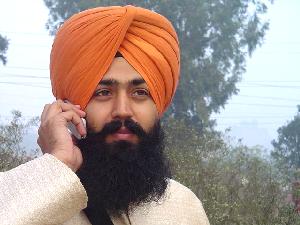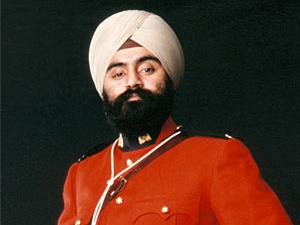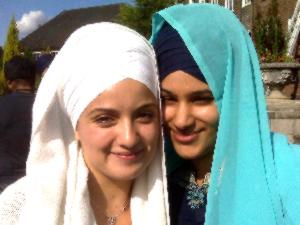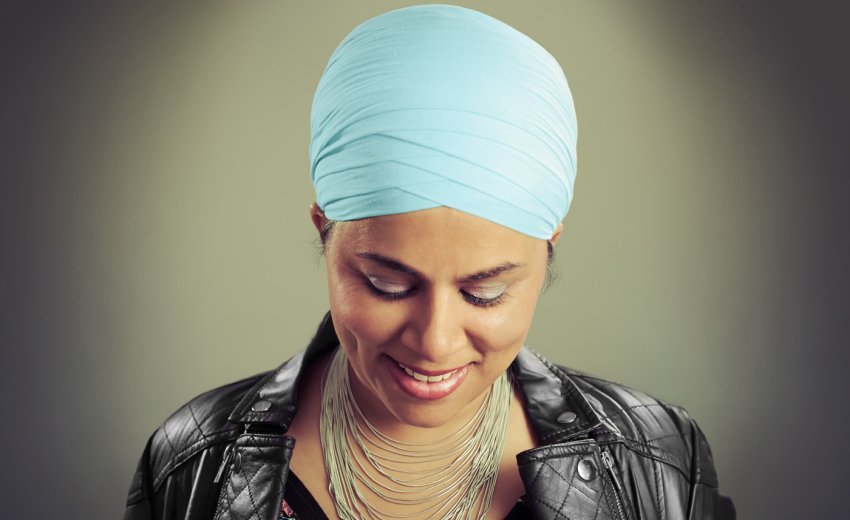Historical Background  Turban is an inseparable part of a Sikh's life. Since Guru Nanak, the founder of Sikhism, all Sikhs have been sporting a turban. Refer to Dr. Trilochan Singh's "Biography of Guru Nanak." All Sikh Gurus sported turban. The Sikh Rehat Maryada (Sikh Code of Conduct) specifically says that all Sikhs must wear a turban. According to the Rehatnama, compiled after a few years of Guru Gobind Singh's demise, the five Kakars of Sikhism were : Kachh (a knee-length underwear), Karha (a iron bangle), Kirpan (a sword), Kangha (comb) and Keski (a small turban).
Turban is an inseparable part of a Sikh's life. Since Guru Nanak, the founder of Sikhism, all Sikhs have been sporting a turban. Refer to Dr. Trilochan Singh's "Biography of Guru Nanak." All Sikh Gurus sported turban. The Sikh Rehat Maryada (Sikh Code of Conduct) specifically says that all Sikhs must wear a turban. According to the Rehatnama, compiled after a few years of Guru Gobind Singh's demise, the five Kakars of Sikhism were : Kachh (a knee-length underwear), Karha (a iron bangle), Kirpan (a sword), Kangha (comb) and Keski (a small turban).
Guru Gobind Singh is quoted as saying :
"Kangha dono vakt kar, paag chune kar bandhai."
Translation:
"Comb your hair twice a day and tie your turban carefully, turn by turn."
Bhai Chaupa Singh writes :
"Kachh, karha, kirpan, kangha, keski, Eh panj kakar rehat dhare Sikh soi.
Translation: The five Kakars of Sikhism are, knee-length underwear, iron bangle, sword, comb, and small turban. A person who wears all these Sikh symbols should be considered a Sikh. Several old Sikh documents refer to the order of Guru Gobind Singh about wearing five Ks.
Bhai Rattan Singh Bhangu is one of the most famous old Sikh historians. He is the author of "Sri Gur Panth Parkash" which he wrote almost one and half century ago. He writes : "Doi vele utth bandhyo dastare, pahar aatth rakhyo shastar sambhare | . . . Kesan ki kijo pritpal, nah(i) ustran se katyo vaal |"
Translation:
"Tie your turban twice a day and carefully wear weapons 24 hours a day. . . Take good care of your hair. Do not cut your hair."
("Sri Gur Panth Parkash" by Bhai Rattan Singh Bhangu, page 7)
Holiness and SpiritualityTurban is a symbol of spirituality in Sikhism. Guru Angad honored Guru Amardas with a turban (Siropa) when he was seated as the Guru.
The most revered Sikh symbol is hair. The turban is required by every Sikh in order to cover his / her hair. This is the primary reason the comb (kangha) is one of the five basic requirements of the Sikh way of life. The turban (Dastaar) has remained the key aspect of a Sikh's honour.
Those who have selflessly served the community are honoured with turbans. Initiation ceremony is the most important ceremony in a Sikh's life. That ceremony cannot be complete without the injunction of always wearing a turban. Indeed, a short-turban (called a keski) is one of the five requirements of initiated Sikhs.
All the Sikh Gurus sported turban. Throughout our short history, all Sikhs also sported turbans. The turban has become synonymous with Sikhism. Yet, other religions such as Hinduism, Islam and even Christianity have similar tenets as evidenced by the following:
Once they enter the gates of the inner Court, they are to wear linen vestments. They shall wear linen turbans, and linen drawers on their loins.
(Old Testament: Ezekiel 44:18-19)
Turban as an Honour
The highest honour that a Sikh religious organization can bestow upon an individual is a Siropa. It is a blessing of the Guru which is bestowed upon a person who has devoted a major portion of his / her life for the welfare of the Sikh community or humanity in general. Sometimes a Siropa is also bestowed upon the families of Sikhs martyrs.
Turban in Social Life
Muslim men and women in many countries still wear turban. It is said that the Egyptians removed their turban during mourning. Even in Punjab, removing a turban from a person's head was, at one time, considered a sign of mourning . Bhai Gurdas, a Sikh savant, who was contemporary of the third, fourth, fifth and sixth Nanak, writes in his Vars :
Tthande khuhu naike pag visar(i) aya sir(i) nangai | Ghar vich ranna(n) kamlia(n) dhussi liti dekh(i) kudhange |
(Vara(n) Bhai Gurdas, Var 32, pauri 19)
Translation:
A person, after taking a bath at the well during winter time, forgot his turban at the well and came home bareheaded. When the women saw him at home without a turban, they thought someone had died and they started to cry.
There are many Punjabi idioms and proverbs that describe how important is a turban in one's life.
Pag Vatauni (Exchange of Turban)
People in Punjab have been and still do exchange turbans with closest friends. Once they exchange turbans they become friends for life and forge a permanent relationship. They take a solemn pledge to share each other's joys and sorrows under all circumstances. Exchanging turban is a glue that binds two individuals or familes together for generations.
Turban as a Symbol of Responsibility
People who have lived in India would know the turban tying ceremony known as Rasam Pagri (ceremonial turban tying). This ceremony takes place when a man passed away and his eldest son takes over the family responsibilities by tying turban in front of a large gathering. It signifies that now he has shouldered the responsibility of his father and he is the head of the family.
Turban and Sikh Military Life  Turban is a symbol of honor and self-respect. The Sikh Army fought their last major battle against the British in 1845. All the Sikh soldiers and generals fought for the respect of "turban and beard" which symbolize Sikh way. Shah Muhammad, a great Punjabi Muslim poet and historian, who witnessed that war, writes:
Turban is a symbol of honor and self-respect. The Sikh Army fought their last major battle against the British in 1845. All the Sikh soldiers and generals fought for the respect of "turban and beard" which symbolize Sikh way. Shah Muhammad, a great Punjabi Muslim poet and historian, who witnessed that war, writes:
Pishe baitth Sardara(n) Gurmatta kita, koi akal da karo ilaj yaro. Sherh burshia(n) di sade pesh ayee, pag dahrhia(n) di rakho laaj yaro.
Freely translated, it says : The Sikh chiefs took a unanimous and firm religious decision (Gurmatta), that they should have sense enough to judge the tenor of Maharani Jind Kaur and the crafty Britishers. They said that they were facing a very shrewd enemy and it was high time for them to save the honor of their turbans and beards (both symbols of self-respect).
The Sikh soldiers refused to wear helmets during World War I and World War II. They fought with turbans on their heads. A Sikh would have had to remove his turban to wear a helmet which could not even be imagined. Many Sikhs received Victoria Cross, one of the most prestigious gallantry awards in the British army, for their bravery.
Many Sikhs refused to remove their turban even during their imprisonment. Bhai Randhir Singh, a widely respected Sikh preacher, scholar, and a freedom fighter had to undergo a fast to win his right to wear turban in prison.
High Moral Values
Sikh history is full of accounts of men and women of other faiths, like Hindus and Muslims, felt safe when there was a Sikh around them. They felt secure from invaders and other people when Khalsa was around. The women and the oppressed would feel safe and protected around a Khalsa. It was a common saying in Punjab :
"Aye nihang, booha khol de nishang"
Translation:
The Nihangs (Sikhs) are at the door. Dear woman ! go ahead open the door without any fear whatsoever.
In the ancient times, the Sikhs had to fight tough battles with the rulers. They moved from village to village at night. Sometimes they had to hide. Women folk had a very high degree of trust in the Sikhs who were clearly identifiable from a turban and beard. Women knew that the Sikhs had high moral character and never mistreated or molested women. So they fed them and helped them in whatever way they could.
Turban for Spiritual Excellence Sometimes with gurus grace our 10th door opens up.It is very easy to open the 10th door if anyone does naam simran in amrit vela.
Sometimes with gurus grace our 10th door opens up.It is very easy to open the 10th door if anyone does naam simran in amrit vela.
there is a vibration travels into the head and kesh helps to increase that vibration up to hundred times and turban helps that vibration to stay longer in the head as well as in the body.
The tenth gate is spoken of in Gurbani........In Sukhmani Sahib:
"The Lord placed the soul in the body cave, while the air held the music of life. And he made each one with nine gates...with the tenth, remaining well hidden. the tenth door is open to the one who truely loves the Gurus' wisdom. And there resounds the Name in myriad forms. It is a treasure that none can imagine. Says Nanak. Oh hear the nectar Name and become pure. For the TRUTH is what you were created to hear."
The hair is coiled up on the tenth gate. The coil and turban's pressure on the meridians of the skull recirculate this very precious subtle energy. The turban will protect that spot (it is the soft spot on the newborn baby's head) of the tenth gate and help you maintain the elevated awareness that one have achieved and keep it there when one go about daily activities.
Turban a Symbol of Zeal and Courage
There are many references in the Sikh history that describe how Guru Gobind Singh personally tied beautiful dumalas (turbans) on the heads of both his elder sons Baba Ajit Singh and Baba Jujhar Singh and how he personally gave them arms and sent them to the battlefield at Chamkaur Sahib where they both embraced martyrdom. When the Sikhs organise an agitation (morcha), they usually wear a saffron color turban which is a symbol of sacrifice and martyrdom.
Beauty:
"khoob teri pagri, meethae tere bolo"
In the ancient Egyptian civilization turban was an ornamental head dress. They called it pjr from which is perhaps derived the word "pugree" commonly used in India and other Asian countries.
Turban was taken as a sign of royalty and now it has become a sign of Sardari. In the Mughal times, it was meant only for aristocracy and the subjects were not allowed to wear turban and kirpan.
Most Respectful
Bare head is not considered appropriate as per Gurbani:
"ud ud ravaa jhaate paaye, vekhe log hasae ghar jaaye"
Identity
It provides Sikhs a unique identity. You will see only Sikhs wearing turban in western or majority of eastern countries. If a Sikh wishes to become one with the Guru, he / she must look like the Guru (wear a turban). Guru Gobind Singh says :
"Khalsa mero roop hai khaas. Khalse me hau karo niwas."
Translation:
Khalsa (Sikh) is a true picture of mine. I live in the Khalsa.
According to the historical accounts, Guru Gobind Singh tied an 18 inch high dumala (turban) just before His light merged in the Supreme Light. Sikh men commonly wear a peaked turban that serves partly to cover their long hair, which is never cut out of respect for God's creation. Devout Sikhs also do not cut their beards, so many Sikh men comb out their facial hair and then twist and tuck it up into their turbans along with the hair from their heads. Sikhism originated in northern India and Pakistan in the 15th century and is one of the youngest of the world's monotheistic religions. There are an estimated 18 million Sikhs in the world, with some 2 million spread throughout North America, Western Europe and the former British colonies.
Gur Fateh !
Jeet Singh

